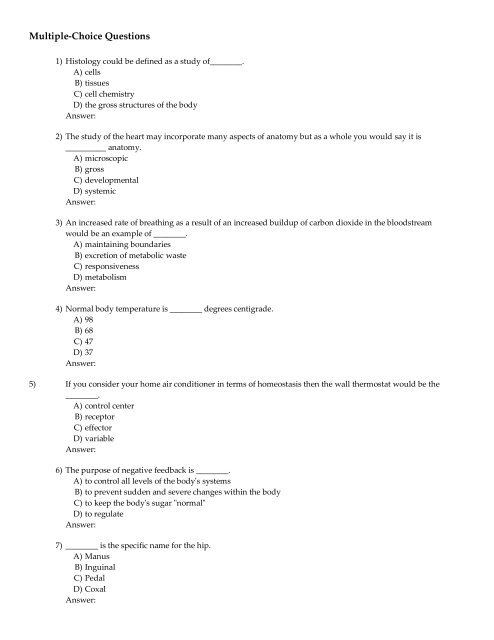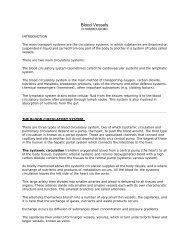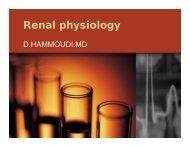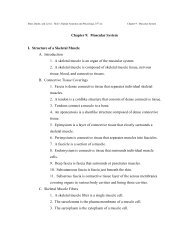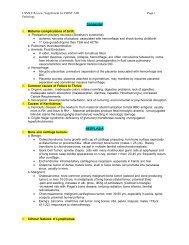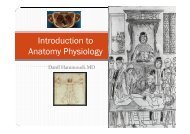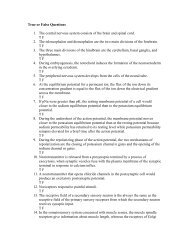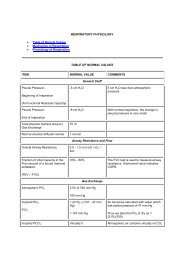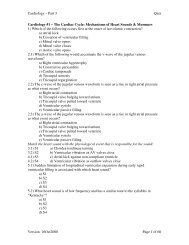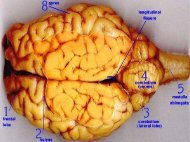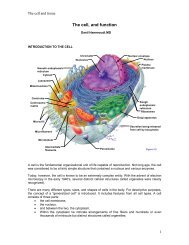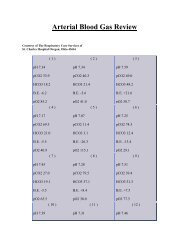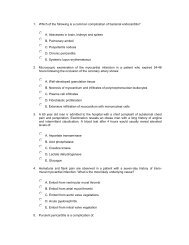Multiple-Choice Questions - Sinoe medical homepage.
Multiple-Choice Questions - Sinoe medical homepage.
Multiple-Choice Questions - Sinoe medical homepage.
You also want an ePaper? Increase the reach of your titles
YUMPU automatically turns print PDFs into web optimized ePapers that Google loves.
<strong>Multiple</strong>‐<strong>Choice</strong> <strong>Questions</strong><br />
1) Histology could be defined as a study of________.<br />
A) cells<br />
B) tissues<br />
C) cell chemistry<br />
D) the gross structures of the body<br />
Answer:<br />
2) The study of the heart may incorporate many aspects of anatomy but as a whole you would say it is<br />
__________ anatomy.<br />
A) microscopic<br />
B) gross<br />
C) developmental<br />
D) systemic<br />
Answer:<br />
3) An increased rate of breathing as a result of an increased buildup of carbon dioxide in the bloodstream<br />
would be an example of ________.<br />
A) maintaining boundaries<br />
B) excretion of metabolic waste<br />
C) responsiveness<br />
D) metabolism<br />
Answer:<br />
4) Normal body temperature is ________ degrees centigrade.<br />
A) 98<br />
B) 68<br />
C) 47<br />
D) 37<br />
Answer:<br />
5) If you consider your home air conditioner in terms of homeostasis then the wall thermostat would be the<br />
________.<br />
A) control center<br />
B) receptor<br />
C) effector<br />
D) variable<br />
Answer:<br />
6) The purpose of negative feedback is ________.<br />
A) to control all levels of the bodyʹs systems<br />
B) to prevent sudden and severe changes within the body<br />
C) to keep the bodyʹs sugar ʺnormalʺ<br />
D) to regulate<br />
Answer:<br />
7) ________ is the specific name for the hip.<br />
A) Manus<br />
B) Inguinal<br />
C) Pedal<br />
D) Coxal<br />
Answer:
8) An oblique cut is one that ________.<br />
A) is cut horizontal right and left<br />
B) is cut between the vertical and horizontal<br />
C) is cut vertical right and left<br />
D) is cut perpendicular to vertical and horizontal<br />
Answer:<br />
9) The heart lies in the ________ cavity.<br />
A) dorsal mediastium<br />
B) ventral pleural<br />
C) dorsal pericardial<br />
D) ventral pericardial<br />
Answer:<br />
10) ________ cavities are spaces between bones.<br />
A) Nasal<br />
B) Synovial<br />
C) Orbital<br />
D) Oral<br />
Answer:<br />
11) A structure that is composed of two or more tissues would be ________.<br />
A) a complex tissue<br />
B) an organ system<br />
C) an organ<br />
D) a complex cell<br />
Answer:<br />
12) The cavities between bones are called __________ cavities.<br />
A) parietal<br />
B) pericardial<br />
C) vertebral<br />
D) synovial<br />
Answer:<br />
13) Which of the following would not be functional characteristics of life<br />
A) movement<br />
B) responsiveness to external stimuli<br />
C) maintenance of boundaries<br />
D) decay<br />
Answer:<br />
14) ________ means toward or at the back of the body, behind.<br />
A) Anterior<br />
B) Lateral<br />
C) Distal<br />
D) Dorsal<br />
Answer:<br />
15) The single most abundant chemical substance of the body, accounting for 60 to 80% of body weight, is<br />
________.<br />
A) oxygen
B) protein<br />
C) water<br />
D) hydrogen<br />
Answer:<br />
16) The posterior side of the patella would be called ________.<br />
A) sural<br />
B) crural<br />
C) antecubital<br />
D) popliteal<br />
Answer:<br />
17) Which of the following statements is true concerning feedback mechanisms<br />
A) Positive feedback mechanisms always result in excessive damage to the host.<br />
B) Negative feedback mechanisms tend to increase the original stimulus.<br />
C) Negative feedback mechanisms work to prevent sudden severe changes within the body.<br />
D) Blood glucose levels are regulated by positive feedback mechanisms.<br />
Answer:<br />
18) The anatomical position is characterized by all of the following except ________.<br />
A) body erect<br />
B) arms at sides<br />
C) palms turned posteriorly<br />
D) thumbs pointed laterally<br />
Answer:<br />
19) A good example of a positive feedback mechanism would be ________.<br />
A) body temperature regulation<br />
B) regulating glucose levels in the blood<br />
C) enhancement of labor contractions by oxytocin<br />
D) blood calcium level regulation<br />
Answer:<br />
20) A parasagittal plane is ________.<br />
A) a transverse cut just above the knees<br />
B) two cuts dividing the body into left and right halves<br />
C) any sagittal plane except the median<br />
D) any cut dividing the body into anterior and posteriOR
21) Which of the following organs or structures would be found in the left iliac region<br />
A) appendix<br />
B) stomach<br />
C) liver<br />
D) intestines<br />
Answer:<br />
22) The parietal pleural would represent a serous membrane ________.<br />
A) covering individual lungs<br />
B) lining the thoracic cavity<br />
C) covering the heart<br />
D) lining the abdominal cavity<br />
Answer:<br />
23) Which one of the following is considered a functional system rather than an organ system<br />
A) endocrine<br />
B) lymphatic<br />
C) immune<br />
D) nervous<br />
Answer:<br />
24) Choose the anatomical topic and definition that is not correctly matched.<br />
A) Gross anatomy: study of structures visible to the eye.<br />
B) Microscopic anatomy: study of structures too small to be seen by the naked eye.<br />
C) Developmental anatomy: study of the changes in an individual from birth through old age.<br />
D) Embryology: study of the changes in an individual from conception to birth.<br />
Answer:<br />
25) Homeostasis is the condition in which the body maintains ________.<br />
A) the lowest possible energy usage<br />
B) a relatively stable internal environment, within limits<br />
C) a static state with no deviation from preset points<br />
D) a dynamic state within an unlimited range<br />
Answer:<br />
26) The lungs are located in the following cavities ________.<br />
A) pleural, ventral, and thoracic<br />
B) mediastinum, thoracic, and ventral<br />
C) pleural, dorsal, and abdominal<br />
D) pericardial, ventral, and thoracic<br />
Answer:<br />
27) Choose the following statement that is not completely correct regarding serous membranes.<br />
A) Serosa are very thin, doublelayered structures.<br />
B) Serous membranes are divided into parietal and visceral membranes with a potential space between<br />
the two.<br />
C) Visceral pericardium covers the surface of the heart, and parietal pericardium lines the walls of the<br />
heart.<br />
D) Serous membranes secrete a watery lubricating fluid.<br />
Answer:
28) Place the following in correct sequence from simplest to most complex:<br />
1. molecules<br />
2. atoms<br />
3. tissues<br />
4. cells<br />
5. organ<br />
A) 12345<br />
B) 21435<br />
C) 21345<br />
D) 12435<br />
Answer:<br />
29) Which of the following imaging devices would best localize a tumor in a personʹs brain<br />
A) X ray<br />
B) DSA<br />
C) PET<br />
D) MRI<br />
Answer:<br />
30) Which of these is not part of the dorsal cavity<br />
A) cranial cavity<br />
B) thoracic cavity<br />
C) spinal cord<br />
D) vertebral cavity<br />
Answer:<br />
31) The spleen is located in which abdominopelvic quadrant<br />
A) right upper<br />
B) right lower<br />
C) left upper<br />
D) left lower<br />
Answer:<br />
32) Which of the following statements is most correct of homeostatic imbalance<br />
A) It is considered the cause of most diseases.<br />
B) The internal environment is becoming more stable.<br />
C) Positive feedback mechanisms are overwhelmed.<br />
D) Negative feedback mechanisms take over.<br />
Answer:<br />
33) Subdivisions of anatomy include ________.<br />
A) gross, macroscopic, visual, and microscopic<br />
B) gross, regional, dissection, and surface<br />
C) regional, surface, visual, and microscopic<br />
D) gross, regional, systemic, and surface<br />
Answer:<br />
34) The term pollex refers to the ________.<br />
A) great toe<br />
B) calf<br />
C) fingers<br />
D) thumb
Answer:<br />
35) The dorsal body cavity is the site of which of the following<br />
A) intestines<br />
B) brain<br />
C) lungs<br />
D) liver<br />
Answer:<br />
36) Select the statement that is most correct.<br />
A) The immune system is a functional system rather than a structural system.<br />
B) Organ systems operate independently to maintain life.<br />
C) The endocrine system is not a true structural organ system.<br />
D) Organ systems can be composed of cells or tissues, but not both.<br />
Answer:<br />
37) One of the functional characteristics of life is irritability. This refers to ________.<br />
A) indigestible food residues stimulating the excretory system<br />
B) sensing changes in the environment and then reacting or responding to them<br />
C) the nervous system causing all living things to sometimes experience anger<br />
D) the necessity for all organisms to reproduce<br />
Answer:<br />
38) Survival needs of the body include ________.<br />
A) nutrients, water, movement, and reproduction<br />
B) nutrients, water, growth, and reproduction<br />
C) water, atmospheric pressure, growth, and movement<br />
D) nutrients, water, atmospheric pressure, and oxygen
Answer<br />
39) The frontal plane is also called the ______ plane.<br />
A) vertical<br />
B) oblique<br />
C) coronal<br />
D) median<br />
Answer:<br />
40) The anatomical position is used ________.<br />
A) rarely, because people donʹt usually assume this position<br />
B) as a standard reference point for directional terms regardless of the actual position of the body<br />
C) only when a body is lying down<br />
D) as the most comfortable way to stand when dissecting a cadaver<br />
Answer:<br />
41) A horizontal section through the body is called ________.<br />
A) frontal<br />
B) regional<br />
C) sagittal<br />
D) transverse<br />
Answer:<br />
42) A vertical section through the body, dividing it into left and right, is called ________.<br />
A) frontal<br />
B) regional<br />
C) sagittal<br />
D) transverse<br />
Answer:<br />
43) A vertical section through the body, dividing it into anterior and posterior, is called ________.<br />
A) frontal<br />
B) median<br />
C) sagittal<br />
D) transverse<br />
Answer:<br />
44) Which body cavity protects the nervous system<br />
A) Cranial<br />
B) Dorsal<br />
C) Vertebral<br />
D) Thoracic<br />
Answer:<br />
Fill‐in‐the‐Blank/Short Answer <strong>Questions</strong><br />
1) ________ consist of similar cells that have a common function.<br />
Answer:<br />
2) The ________ system secretes hormones that regulate growth processes and nutrient usage by body cells.<br />
Answer:<br />
3) ________ is a term that describes the back of the elbow
Answer:<br />
4) ________ is a term that describes the heel region.<br />
Answer:<br />
5) The elbow is ________ to the wrist.<br />
Answer:<br />
6) The ________ cavity contains tiny bones that transmit sound vibrations to the organ of hearing in the inner<br />
ear.<br />
Answer:<br />
7) ________ is explained by chemical and physical principles and is concerned with the function of specific<br />
organs or organic systems.<br />
Answer:<br />
8) ________ is a dynamic equilibrium of your internal environment.<br />
Answer:<br />
9) The ________ cavity contains the bladder, some reproductive organs, and the rectum.<br />
Answer:<br />
10) ________ peritoneum is the serous membrane that covers the intestines.<br />
Answer:<br />
11) ________ physiology concerns urine production and kidney function.<br />
Answer:<br />
12) ________ is a broad term that covers all chemical reactions that occur within the body cells.<br />
Answer:<br />
13) What is the function of the serous membranes<br />
Answer:<br />
14) Fully describe the anatomical position for the human body.<br />
Answer:<br />
15) Gross anatomy refers to:<br />
Answer:<br />
16) Can lungs carry out excretory functions Explain.<br />
Answer:<br />
17) The higher we go in the mountains the greater the atmospheric pressure which causes a loss of oxygen.<br />
Comment on this statement.<br />
Answer:<br />
18) Why is anatomical terminology necessary<br />
Answer:<br />
19) The lungs are ________ to the skin.<br />
Answer:<br />
20) The five cavities of the head are cranial, oral, nasal, middle ear, and ______.
Answer:<br />
Clinical <strong>Questions</strong><br />
1) A small family was traveling in its van and had a minor accident. The children in the back seats were<br />
wearing lap belts, but still sustained numerous bruises about the abdomen, and had some internal organ<br />
injuries. Why is this area more vulnerable to damage than others<br />
Answer:<br />
2) A surgeon removed a section of tissue along a transverse plane for microscopic examination. What two<br />
names would the section be called<br />
Answer:<br />
3) Judy is 16 years old and collapses on the gym floor in severe pain to her chest wall. She is rushed by<br />
ambulance to the emergency room. Judy is diagnosed with pleurisy and is given an antiinflammatory<br />
through the intravenous route. Explain why an antiinflammatory would be prescribed for someone with<br />
pleurisy.<br />
Answer:<br />
4) Explain why an 80yearold woman requires a much longer time to recover from the flu versus a woman<br />
who is age 30.<br />
Answer:<br />
5) The nurse charted: ʺClient has an open wound located on lateral aspect of leg.ʺ Describe where the wound is<br />
located.<br />
Answer:<br />
6) The client was admitted to the hospital with hypertension. The development of arteriosclerosis has<br />
increased peripheral resistance to blood flow, worsening his hypertension. This is an example of what type<br />
of feedback loop and why Answer


